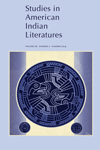Hollenberg, Alexander. “Speaking with the Separatists: Craig Womack and the Relevance of Literary History.” Studies in American Indian Literatures 2009: 1-17. JSTOR Journals. Web. 15 Sept. 2014.
In his defense of Womack’s work Red on Red and his theory of a literary separatism, Hollenberg argues that Womack’s work must be seen through the lens of literary relevance, or “what it really means for a literary history to be relevant” (2). Hollenberg—a white, Canadian scholar with a full understanding of the scary implications of “separatism”—argues that we should understand Womack’s work as a call for enriching and true dialogue, not as a schism between white and/or multiculturalist scholars and Native scholars/writers, but rather as (as Womack intends) a Creek sovereignty in which “a Creek community…defines and evaluates itself internally by reimagining its own borders” (2).
Hollenberg argues we should understand that Womack is arguing for the hybridity of Creek identity, in which a Creek individual exists within the Creek community and outside of the Creek community, which suggests a “permeability” of borders that should make clear (since a Creek individual exists in multiple communities outside of the Creeks) that Womack is not arguing for ethnic exclusivism, but instead for a Native consciousness that is “separate yet integrative” (5). Through this, the Creeks can create a literary history and theory “that speaks for and, even more importantly, to itself” (2). Hollenberg acknowledges this view is difficult for pluralists, multiculturalists, and postmodernists to swallow, and in his essay addresses the multiculturalist scholars Arnold Krupat and Elvira Pulitano’s reactions to Womack’s work. Hollenberg argues that their criticism of Womack’s work, along with the criticism coming from a number of multiculturalists and postmodernists, falls exactly into the trap Womack warned critics to avoid.
The biggest issue that Womack (and consequently, Hollenberg) point out is that Native American literature should not be used simply “as an instrument of canonical subversion—as if it exists purely to disrupt and defamiliarize the established discourse” (Hollenberg 5). In the cultural and civil rights movements of the sixties, seventies, and even into the early eighties, critics often used literature written by minorities (Native American, African American, Asian American, etc.) as a new lens through which to view and destabilize the center, or the established canon. However, Native American texts (oral or written) have existed far longer than the formal European/American literary canon, and even longer than European contact; in this view, even a cosmopolitan perspective, such as the one adapted by Pulitano in her criticism of Womack, falls short, because “it inevitably presumes that the Indigenous is always in a marginal position” (Hollenberg 7). As Hollenberg questions, “why, we must ask, is the Native subject always first constructed as a borrower in cosmopolitan criticism?,” or, why do “critics unwittingly posit the Native self as always victim” (7)?
Ultimately, Hollenberg fully supports Womack’s approach, and encourages others to support it as well, for “the point of reading a Native literary history is not to feel like a better multiculturalist (comfortable in one’s recognition of difference) but to locate for one’ self the capacity to dialogue and, also, to accept the possibility of not possessing the central and controlling perspective” (8). Hollenberg’s argument then gives me, and other white scholars like me, a direction for how to proceed in consideration of Womack’s work: we are the outsiders, and the traditional methodologies we’ve used to analyze literature won’t necessarily work or be appropriate in analyzing Native American texts. The question remains: what will an Indigenous-centered methodology look like (Womack’s methodology being one example), and how can a white scholar learn it?
